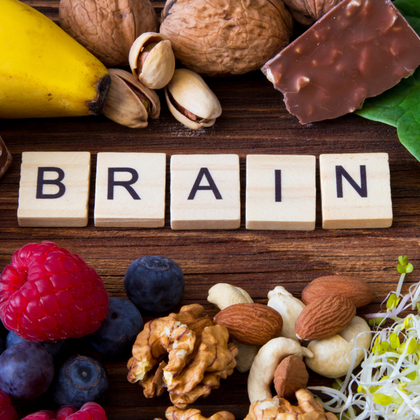
If you have epilepsy, it means you’re prone to epileptic seizures (years ago these used to be called fits). There are several different types of epilepsy that trigger different types of seizures. These can cause problems with things like consciousness, behaviour, emotions, movements and sensations. All of these symptoms are caused by abnormal bursts of intense electrical activity in the brain that affect how it works for a short period of time.
According to the charity Epilepsy Action, epilepsy is one of the most common serious neurological conditions in the world (i). Seizures are particularly common, with an estimated one in 20 people having a seizure at some point in their life (ii). However, you’ll usually only be diagnosed with epilepsy if you’ve had more than one seizure. That’s because many people only ever have one seizure during their lifetime.
People who are diagnosed with epilepsy can have their first seizure at any age, and for many it’s a life-long condition (though some people eventually stop having seizures as they get older). The number of people affected in the UK is thought to be around 600,000 – that’s the equivalent of almost one in 100 (i).
What causes epilepsy?
In more than half of all epilepsy cases there is no known cause at all – this is called idiopathic epilepsy. Some of the causes we do know about include damage to the brain or an underlying brain condition, some of which you can be born with while others can develop later in life. Examples include:
-
Head injuries
-
Stroke
-
Scar tissue in part of your brain
-
Brain infections (for example meningitis or encephalitis)
-
Cerebral palsy
-
Brain growths or tumours
-
Some genetic syndromes
Experts think your genes can affect whether or not you develop epilepsy too, and according to Epilepsy Action several genes have already been linked to certain types of epilepsy (i). So if you have one or more family members with epilepsy, your risk could be higher than average.
The good news is that most people who have epilepsy lead normal lives thanks to modern treatments that aim to help them have fewer seizures or even stop having seizures altogether. Those who have idiopathic epilepsy, for instance, have a very good chance of controlling their seizures fully with medication.
According to Patient (ii):
-
Almost half of people with epilepsy don’t have any seizures during a five-year period. Most of these people take epilepsy medication, while others no longer take any medication after having two or more seizure-free years while on medication.
-
Around three in 10 people with epilepsy have some seizures during a five-year period, but they have far fewer seizures than if they hadn’t been taking medication.
-
Only two out of 10 people with epilepsy continue to have seizures despite taking medication.
Children who have epilepsy can go to school and take part in most sports and activities too. However if you have epilepsy there are a few things you may need to think carefully about, such as driving, swimming and doing certain types of jobs.
What are the different types of epilepsy seizures?
Different types of epilepsy affect different parts of the brain.
The largest section of the brain is called the cerebrum. This is comprised of two halves – the right half (or hemisphere), which controls the left side of the body, and the left half, which controls the right. Epileptic seizures can start in one hemisphere or both hemispheres:
-
If a seizure starts in one hemisphere, it is called a focal seizure (some focal seizures may start in one hemisphere but they can sometimes spread to both hemispheres). Focal seizures used to be called partial seizures.
-
If both hemispheres of the brain are affected from the start of the seizure, it’s known as a generalised seizure.
What are the main types of focal seizures?
Focal seizures vary according to the area of the brain that’s affected and whether or not the seizure spreads to affect other areas. There are two main types:
1. Simple focal seizures don’t cause unconsciousness, which means you are awake and fully aware of what’s happening. Symptoms depend on which area or lobe of the brain is affected, and whether or not the seizure spreads to affect other lobes or the other hemisphere. Some of these symptoms include:
-
Feeling strange in general
-
An unusual taste in your mouth
-
Feeling like you have butterflies in your stomach (like the sensation you get on a rollercoaster, for instance)
-
Twitching in part of your body (a hand or arm, for instance)
-
Tingling or pins and needles in your arms and legs
-
Intense feelings of fear or joy
Simple focal seizures are often called auras, as they can be a sign that you’re about to have another type of seizure.
2. Complex focal seizures start in the temporal lobe of the brain and are often called temporal lobe epilepsy. Unlike simple focal seizures your awareness is affected, so you won’t be able to respond to another person while it’s happening and you won’t remember what happened afterwards. The symptoms can be quite peculiar, including:
-
Mumbling
-
Chewing or swallowing
-
Wandering aimlessly
-
Fiddling with objects
-
Picking at your clothes
-
Making random noises
-
Smacking your lips
-
Rubbing your hands
-
Strange emotions, fears, feelings, visions and sensations
If a focal seizure develops into a generalised seizure – that is, if it spreads into both hemispheres of the brain – it is known as a secondary generalised seizure.
What are the symptoms of generalised seizures?
When a burst of abnormal electrical activity affects all or most of the brain (that is, both hemispheres of the cerebrum), the symptoms tend to be more general and usually affect several parts of the body. The main types of generalised seizure include:
1. Tonic-clonic seizure. When most people think of an epileptic seizure or fit, what they’re probably thinking about is a tonic-clonic seizure (or a grand-mal seizure, as they used to be called years ago). This is when your whole body stiffens, you fall to the floor and lose consciousness, then uncontrollable muscle contractions make your body start to shake and twitch. Sometimes you can also lose control of your bladder.
Tonic-clonic seizures normally last for a few minutes, though some people can be affected for longer. Afterwards you may have a headache and feel tired and generally unwell, plus you may feel confused or have memory problems. Most people feel better after an hour or two, but it can take a few days before you feel yourself again.
Read about what you should do if you see someone having a seizure at www.nhs.uk.
2. Absence seizures, which used to be called petit-mal seizures, can happen several times a day. Typically these make you unaware of your surroundings temporarily – usually for up to 15 seconds – and are most common in children (though they can affect people of any age).
While you’re having an absence seizure you may stare blankly into space, and it can often look as if you’re daydreaming. Some people’s eyes flutter too, or parts of their body may twitch or jerk slightly.
3. Myoclonic seizures often happen first thing in the morning soon after waking. They tend to last just a fraction of a second, when a part of your body (usually one or both arms) suddenly jerks or twitches, either mildly or more forcefully. However, while they don’t usually cause unconsciousness, you can sometimes have several myoclonic seizures in a short space of time. These seizures don’t usually cause any after-effects, and you should be able to go back to whatever you were doing straight away.
4. Tonic seizures are like the first stage of a tonic-clonic seizure, when all your muscles suddenly stiffen. This means that if you’re standing up when one starts, you could lose your balance and fall over. Sometimes tonic seizures only affect one side of your brain, which means your muscles tighten in just one part of your body.
Tonic seizures tend to last less than a minute, then your muscles relax again. You can, however, feel sleepy or confused afterwards.
5. Clonic seizures, on the other hand, are like the second stage of a tonic-clonic seizure. This means your body doesn’t become stiff, but it does start to shake and jerk. Clonic seizures can – but don’t always – cause loss of consciousness, and usually last for a few minutes.
6. Atonic seizures are the opposite of tonic seizures, so instead of all your muscles becoming stiff they suddenly relax and go limp for a second or two. Again, this means that if you’re standing up you could fall over, which could lead to an injury. Some people refer to atonic seizures as drop attacks.
How is epilepsy diagnosed and treated?
It’s not always easy for a doctor to confirm that you’ve had a seizure. However if you think you may have had a seizure it’s important to seek medical advice, if only to rule out other conditions such as fainting, panic attacks and migraines. If your description of what happened makes your GP think you did have a seizure, you’ll usually be referred to a hospital specialist called a neurologist.
There are several tests that can help neurologists make a diagnosis of epilepsy, including different types of brain scans and electroencephalographs (EEGs – where sensors attached to your scalp are connected to a machine to record the electrical activity of your brain). These tests, however, aren’t always accurate, and according to experts it’s possible to have epilepsy with normal test results (similarly, having abnormal test results doesn’t necessarily mean you have epilepsy) (ii).
What are the latest treatment options for epilepsy?
The good news is that if you are diagnosed as having epilepsy, there are treatments that could help you have fewer seizures or to stop having them completely.
Anti-epileptic drugs (AEDs) These medicines are the most commonly used treatments for epilepsy, and according to the NHS they control seizures in about seven out of 10 people with the condition (iii). There are several types of AEDs, which work by changing the levels of chemicals in your brain. Which type will work for you can depend on several factors, including the type of seizures you have, how old you are and whether or not you’re planning to get pregnant. Some people can even stop taking AEDs if they haven’t had a seizure for a few years – however, never stop taking any medicines that are prescribed for you without getting advice from your doctor or specialist first.
AEDs can also be affected by other medicines, including complementary medicines and over-the-counter medicines. This means if you take AEDs you shouldn’t take any other type of medicine without speaking to your GP or specialist. AEDs can also cause a range of side effects, especially during the first few days or weeks after you start taking them – though most people taking AEDs have few or no side effects. You can read more about possible side effects on the information leaflet that comes with your medicine.
Brain surgery If AEDs fail to prevent seizures, and if the seizures start in one small area of the brain, surgery to remove that part of the brain may be recommended (only a minority of people with epilepsy are suitable for this type of surgery).
Vagus nerve stimulation (VNS) This is a treatment that is sometimes offered to people who have seizures that aren’t controlled with AEDs. VNS involves having a small electrical device – a bit like a pacemaker – inserted under your skin below the left collarbone in your chest. The device emits small bursts of electricity along a wire to the vagus nerve in the neck, which is thought to affect electrical signals in the brain and help control seizures.
Similar to VNS is deep brain stimulation (DBS), where a device placed under the skin in the chest is connected to wires that run straight into the brain. DBS is, however, a fairly new procedure and experts still don’t know exactly how effective it is for epilepsy.
Ketogenic diet Children with seizures that aren’t controlled by AEDs are sometimes recommended to follow a ketogenic diet. This diet is very high in fat, low in protein and extremely low in carbohydrates, but it isn’t usually recommended for adults because high-fat diets are believed to lead to other serious health conditions such as cardiovascular disease. The diet has been shown to reduce the number of seizures in some children with epilepsy, but it should only be used with the help of an epilepsy specialist and a dietitian.
Epilepsy and lifestyle: Can you live a normal life?
Most people with epilepsy can keep their seizures under control with medication or other treatments, which means your chance of having a normal life is a pretty good one. Here are some of the ways your lifestyle can help:
Eat a healthy diet Apart from the ketogenic diet, which is usually only recommended for some children with epilepsy, there’s no specific diet that’s thought to have any direct effect on seizures, with no foods thought to trigger seizures or reduce them.
According to the Epilepsy Society, however, there is a chance that caffeine – found in tea, coffee, cola, chocolate and some energy drinks – may increase the likelihood of seizures in some people (though the link between caffeine and seizures is still not very well understood) (iv).
Meanwhile, drinking grapefruit juice and pomegranate juice may make you more likely to experience some side effects of some AEDs (check the information leaflet that comes with your medicines to find out if the AED you’re taking is one of them).
It is a good idea, however, to follow a balanced, nutritious diet, as it’s good for your general health and can help keep your energy levels on an even keel. Eating regular meals can also be helpful, since leaving long periods between eating can make your blood sugar too low – which can trigger seizures in some people (v).
Stay active If you’re fit and healthy you may have fewer seizures, says the Epilepsy Society (vi). Exercise can also improve your mood and help you cope with stress. Aim to do at least 150 minutes of moderate exercise a week, which works out at 30 minutes of physical activity a day for five days of the week.
If you’re not used to exercising, start slowly and work your way up to 150 minutes of activity a week. Try starting with a short walk around the block, then gradually increase the distance you walk.
However, if your seizures aren’t well controlled you may need to take some precautions when it comes to exercise, such as avoiding swimming, wearing a helmet while cycling and avoiding some types of equipment at the gym (ask a supervisor at your gym for further details).
Drink alcohol in moderation Heavy drinking can make you more likely to have a seizure (vii), but drinking small amounts is considered safe – as a general guideline try to stick to the government’s guidelines of no more than 14 units of alcohol a week (though everyone with epilepsy is different, and how much you can drink safely can vary from one person to the next).
Also check whether or not you can drink any alcohol at all while taking AEDs, since alcohol can increase the side-effects of some epilepsy medicines (details can be found on the information leaflet that comes with your medicine).
Tackle stress Stress and anxiety are both possible triggers of epilepsy seizures, which can be a problem since having epilepsy can make you feel more stressed in the first place. According to the NHS stress-relieving and relaxation therapies such as exercise, yoga and meditation may be helpful (iii). Practising mindfulness may be useful too – find out more in our guide to using mindfulness to manage stress.
There’s also more general information on stress and ways of managing it in our guide to stress symptoms and signs.
Sleep well Getting the right amount of sleep is also important if you’ve been diagnosed with epilepsy. According to the Epilepsy Society, some people with epilepsy find a lack of sleep can make seizures more likely to happen, while others who have seizures at night can often feel tired during the day (viii). Epilepsy medicines can also affect your sleep, with some making you feel more tired and others causing insomnia or disrupted sleep. It’s important to make sure you do everything you can to get a good night’s rest – find more details and sleep well tips in our guide to insomnia.
Can you have a safe pregnancy with epilepsy?
If you’re living with epilepsy, experts believe your condition doesn’t affect your ability to have children or a healthy pregnancy (ix). However some AEDs are not suitable for pregnant women as they can affect their unborn baby. So if you’re thinking of trying for a baby, talk things through with your GP beforehand. If the medicines you’re taking could cause a problem, your doctor will suggest alternative AEDs that are safe to use during pregnancy.
Meanwhile some women with epilepsy aren’t affected by pregnancy – in fact it’s possible your condition may even improve while you’re expecting. But if being pregnant is stressing you out you could have more frequent seizures. If this happens, you should inform your GP or specialist.
The NHS also recommends all women with epilepsy take 5mg of folic acid every day as soon as they start trying for a baby (this is a higher dose than that recommended for women who don’t have epilepsy) (x).
Can nutritional supplements help?
Some nutritional supplements may be useful to take alongside the treatment your doctor or specialist has prescribed for you, including the following:
Vitamin B6 Being deficient in vitamin B6 is thought to cause or worsen seizures in some babies and children. Experts at the UCL Great Ormond Street Institute of Child Health and Great Ormond Street Hospital have even discovered a gene fault they believe causes a rare strain of vitamin B6-dependent epilepsy in children (xi). The experts also found that treating these children with vitamin B6 reduced their seizures significantly. However, while B6 deficiency is a recognised cause of epilepsy seizures in babies and children, evidence has also emerged that some adults with epilepsy may be deficient in B6 too, and that treating them with B6 can be effective (xii).
Good sources of B6 include fish, chicken, turkey, pork, soya beans, bananas, peanuts, milk and oats. You can also find it in supplements as an individual vitamin or combined with other nutrients in a B complex or multivitamin and mineral product.
Magnesium Low magnesium levels have often been linked with having more regular seizures, but studies that look at this connection are currently few and far between. There is, however, some evidence that taking magnesium supplements may help reduce the number of seizures in people with epilepsy whose seizures are hard to control with traditional anti-epilepsy medicines (xiii).
If you’re not eating plenty of whole grains, nuts, pulses and green vegetables, you may be among the many people who aren’t getting the magnesium their bodies need. Taking a magnesium supplement can help boost your levels. However not all magnesium supplements are equal. For instance, some are not easily absorbed by the body, so if you’re considering taking magnesium look for a supplement that contains magnesium citrate (this form has been found to be more readily absorbed than some others).
High-strength fish oils The omega-3 fatty acids found in oily fish such as salmon, trout, sardines and mackerel may also help reduce seizures in people who don’t respond to anti-epilepsy medication, says a study by UCLA researchers (xiv). The study was a small one, with just 24 participants, but it found taking fish oil supplements reduced their seizures by more than 30 per cent. If you don’t like eating fish you can get the omega-3s your body needs by taking a good-quality fish oil supplement (or, if you’re a vegetarian or vegan, by taking a supplement that contains omega-3 oils sourced from marine algae).
Is CBD oil good for epileptics?
A note of caution, CBD products you can buy aren’t the same as the medical CBD products that have recently become available on prescription for some types of epilepsy (specifically epilepsy seizures caused by Dravet syndrome and Lennox-Gastaut syndrome). The CBD products that are sold online and in health stores aren’t licensed as medicines, and according to the charity Epilepsy Action they are unlikely to be of the same standard as medical CBD (xv).
CBD products may also affect the way conventional epilepsy medicines work, so if you’re considering using them it’s highly advisable to speak to your doctor or specialist first. Indeed, always tell your doctor or specialist if you’re considering taking any nutritional supplements and are already taking AEDs.
Having epilepsy can often be stressful, but it doesn’t mean you can’t live life to the full. Taking your medication as your doctor or specialist recommends can help keep your seizures to a minimum – or even stop them altogether. Having a healthy lifestyle can also make a big difference to your quality of life. If you need more information and helpful tips about a wide range of health conditions, simply visit our pharmacy health library.
References:
(i) Available online: https://www.epilepsy.org.uk/info/what-is-epilepsy(ii) Available online: https://patient.info/brain-nerves/epilepsy-and-seizures
(iii) Available online: https://www.nhs.uk/conditions/epilepsy/treatment/
(iv) Available online: https://epilepsysociety.org.uk/living-epilepsy/wellbeing-and-epilepsy/diet-and-nutrition
(v) Available online: https://patient.info/brain-nerves/epilepsy-and-seizures/living-with-epilepsy
(vi) Available online: https://epilepsysociety.org.uk/living-epilepsy/wellbeing/exercise
(vii) Available online: https://www.epilepsy.org.uk/info/daily-life/alcohol
(viii) Available online: https://epilepsysociety.org.uk/living-epilepsy/wellbeing/sleep-epilepsy
(ix) Available online: https://www.nhs.uk/conditions/epilepsy/living-with/
(x) Available online: https://www.nhs.uk/pregnancy/related-conditions/existing-health-conditions/epilepsy/
(xi) Available online: https://www.gosh.nhs.uk/press-releases/vitamin-b6-lifesaver-children-severe-epilepsy/
(xii) Tong Y. Seizures caused by pyridoxine (vitamin B6) deficiency in adults: A case report and literature review. Intractable Rare Dis Res. 2014 May; 3(2): 52–56. Available online: https://www.ncbi.nlm.nih.gov/pmc/articles/PMC4204538/
(xiii) Abdelmalik PA, Polizer N, Carlen PL. Magnesium as an Effective Adjunct Therapy for Drug Resistant Seizures. J Neurol Sci. 2012 May;39(3):323-7. Available online: https://www.cambridge.org/core/journals/canadian-journal-of-neurological-sciences/article/magnesium-as-an-effective-adjunct-therapy-for-drug-resistant-seizures/326CC72AD9B5ED9E9A165FEDBBD9141C
(xiv) DeGiorgio CM et al. Fish oil (n-3 fatty acids) in drug resistant epilepsy: a randomised placebo-controlled crossover study. J Neurosurg Psychiatry. 2015 Jan;86(1):65-70. Available online: https://jnnp.bmj.com/content/86/1/65
(xv) Available online: https://www.epilepsy.org.uk/info/treatment/cannabis-based-treatments
Related Posts
Disclaimer: The information presented by Nature's Best is for informational purposes only. It is based on scientific studies (human, animal, or in vitro), clinical experience, or traditional usage as cited in each article. The results reported may not necessarily occur in all individuals. Self-treatment is not recommended for life-threatening conditions that require medical treatment under a doctor's care. For many of the conditions discussed, treatment with prescription or over the counter medication is also available. Consult your doctor, practitioner, and/or pharmacist for any health problem and before using any supplements or before making any changes in prescribed medications.

Keri
Keri Filtness has worked in the Nutrition Industry for 19 years. She is regularly called upon for her professional comments on health and nutrition related news. Her opinions have been featured by BBC3, Prima, Vitality, The Mirror, Woman’s Own and Cycling Weekly, amongst others. She has also worked one to one with journalists, analysing their diets and health concerns and recommending changes and additions, where appropriate.
View More



